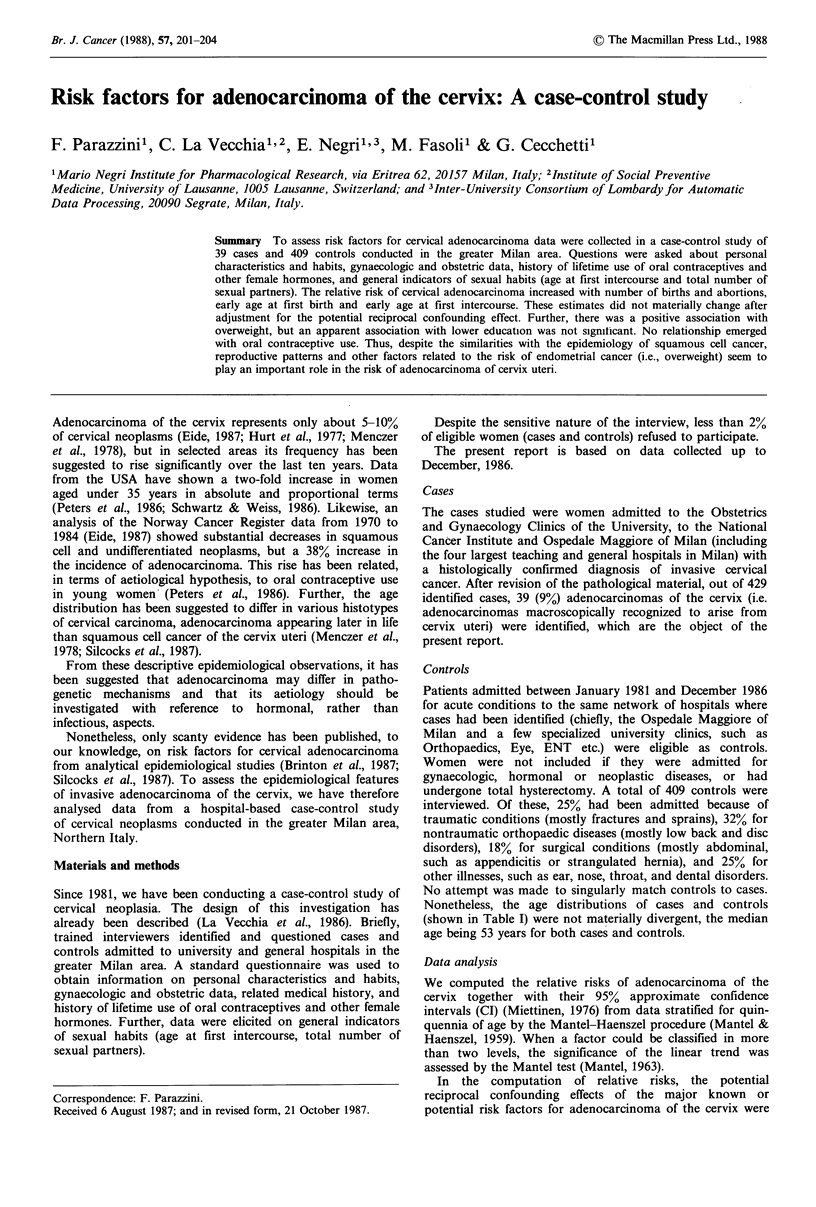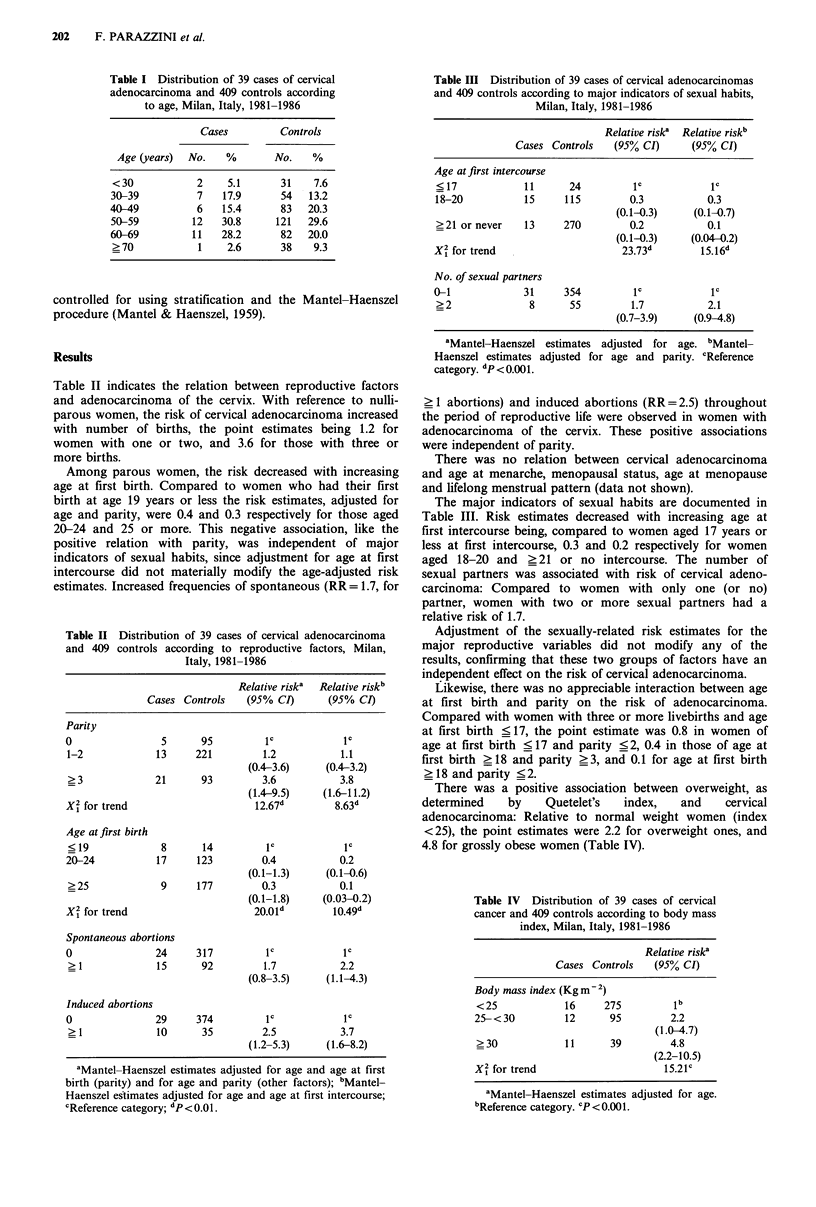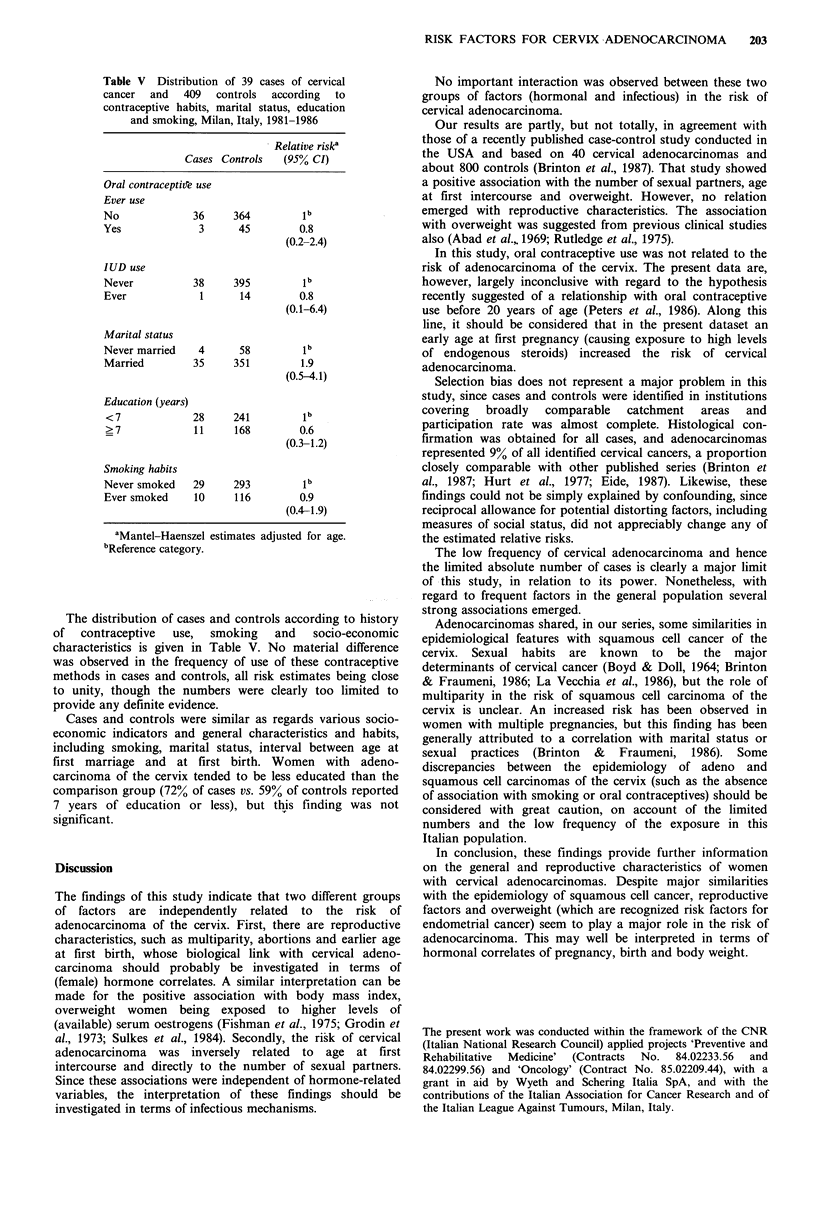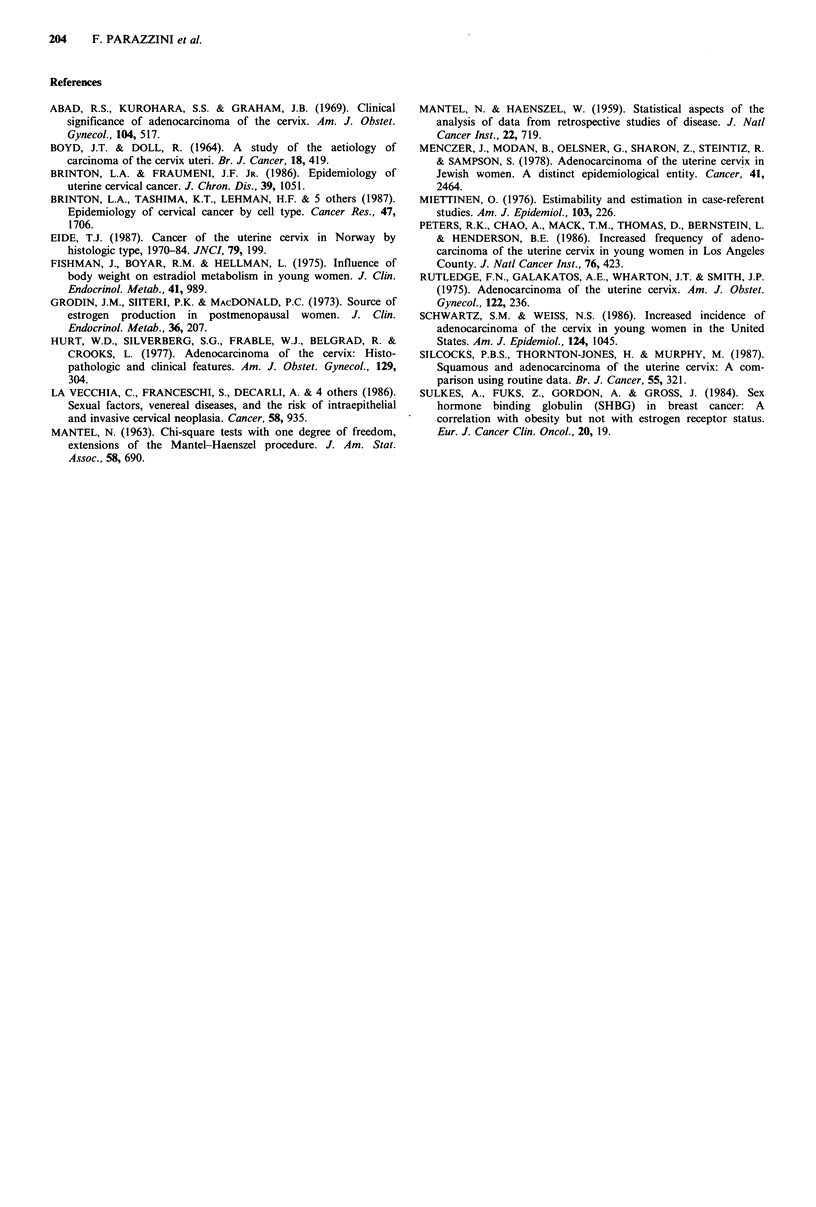Abstract
To assess risk factors for cervical adenocarcinoma data were collected in a case-control study of 39 cases and 409 controls conducted in the greater Milan area. Questions were asked about personal characteristics and habits, gynaecologic and obstetric data, history of lifetime use of oral contraceptives and other female hormones, and general indicators of sexual habits (age at first intercourse and total number of sexual partners). The relative risk of cervical adenocarcinoma increased with number of births and abortions, early age at first birth and early age at first intercourse. These estimates did not materially change after adjustment for the potential reciprocal confounding effect. Further, there was a positive association with overweight, but an apparent association with lower education was not significant. No relationship emerged with oral contraceptive use. Thus, despite the similarities with the epidemiology of squamous cell cancer, reproductive patterns and other factors related to the risk of endometrial cancer (i.e., overweight) seem to play an important role in the risk of adenocarcinoma of cervix uteri.
Full text
PDF



Selected References
These references are in PubMed. This may not be the complete list of references from this article.
- Abad R. S., Kurohara S. S., Graham J. B. Clinical significance of adenocarcinoma of the cervix. Am J Obstet Gynecol. 1969 Jun 15;104(4):517–522. doi: 10.1016/s0002-9378(16)34240-5. [DOI] [PubMed] [Google Scholar]
- BOYD J. T., DOLL R. A STUDY OF THE AETIOLOGY OF CARCINOMA OF THE CERVIX UTERI. Br J Cancer. 1964 Sep;13:419–434. doi: 10.1038/bjc.1964.49. [DOI] [PMC free article] [PubMed] [Google Scholar]
- Brinton L. A., Fraumeni J. F., Jr Epidemiology of uterine cervical cancer. J Chronic Dis. 1986;39(12):1051–1065. doi: 10.1016/0021-9681(86)90139-6. [DOI] [PubMed] [Google Scholar]
- Brinton L. A., Tashima K. T., Lehman H. F., Levine R. S., Mallin K., Savitz D. A., Stolley P. D., Fraumeni J. F., Jr Epidemiology of cervical cancer by cell type. Cancer Res. 1987 Mar 15;47(6):1706–1711. [PubMed] [Google Scholar]
- Eide T. J. Cancer of the uterine cervix in Norway by histologic type, 1970-84. J Natl Cancer Inst. 1987 Aug;79(2):199–205. [PubMed] [Google Scholar]
- Fishman J., Boyar R. M., Hellman L. Influence of body weight on estradiol metabolism in young women. J Clin Endocrinol Metab. 1975 Nov;41(5):989–991. doi: 10.1210/jcem-41-5-989. [DOI] [PubMed] [Google Scholar]
- Grodin J. M., Siiteri P. K., MacDonald P. C. Source of estrogen production in postmenopausal women. J Clin Endocrinol Metab. 1973 Feb;36(2):207–214. doi: 10.1210/jcem-36-2-207. [DOI] [PubMed] [Google Scholar]
- Hurt W. G., Silverberg S. G., Frable W. J., Belgrad R., Crooks L. D. Adenocarcinoma of the cervix: histopathologic and clinical features. Am J Obstet Gynecol. 1977 Oct 1;129(3):304–315. doi: 10.1016/0002-9378(77)90788-8. [DOI] [PubMed] [Google Scholar]
- La Vecchia C., Franceschi S., Decarli A., Fasoli M., Gentile A., Parazzini F., Regallo M. Sexual factors, venereal diseases, and the risk of intraepithelial and invasive cervical neoplasia. Cancer. 1986 Aug 15;58(4):935–941. doi: 10.1002/1097-0142(19860815)58:4<935::aid-cncr2820580422>3.0.co;2-o. [DOI] [PubMed] [Google Scholar]
- MANTEL N., HAENSZEL W. Statistical aspects of the analysis of data from retrospective studies of disease. J Natl Cancer Inst. 1959 Apr;22(4):719–748. [PubMed] [Google Scholar]
- Menczer J., Modan B., Oelsner G., Sharon Z., Steintiz R., Sampson S. Adenocarcinoma of the uterine cervix in Jewish women: a distinct epidemiological entity. Cancer. 1978 Jun;41(6):2464–2467. doi: 10.1002/1097-0142(197806)41:6<2464::aid-cncr2820410655>3.0.co;2-d. [DOI] [PubMed] [Google Scholar]
- Miettinen O. Estimability and estimation in case-referent studies. Am J Epidemiol. 1976 Feb;103(2):226–235. doi: 10.1093/oxfordjournals.aje.a112220. [DOI] [PubMed] [Google Scholar]
- Peters R. K., Chao A., Mack T. M., Thomas D., Bernstein L., Henderson B. E. Increased frequency of adenocarcinoma of the uterine cervix in young women in Los Angeles County. J Natl Cancer Inst. 1986 Mar;76(3):423–428. [PubMed] [Google Scholar]
- Rutledge F. N., Galakatos A. E., Wharton J. T., Smith J. P. Adenocarcinoma of the uterine cervix. Am J Obstet Gynecol. 1975 May;122(2):236–245. doi: 10.1016/s0002-9378(16)33496-2. [DOI] [PubMed] [Google Scholar]
- Schwartz S. M., Weiss N. S. Increased incidence of adenocarcinoma of the cervix in young women in the United States. Am J Epidemiol. 1986 Dec;124(6):1045–1047. doi: 10.1093/oxfordjournals.aje.a114474. [DOI] [PubMed] [Google Scholar]
- Silcocks P. B., Thornton-Jones H., Murphy M. Squamous and adenocarcinoma of the uterine cervix: a comparison using routine data. Br J Cancer. 1987 Mar;55(3):321–325. doi: 10.1038/bjc.1987.63. [DOI] [PMC free article] [PubMed] [Google Scholar]
- Sulkes A., Fuks Z., Gordon A., Gross J. Sex hormone binding globulin (SHBG) in breast cancer: a correlation with obesity but not with estrogen receptor status. Eur J Cancer Clin Oncol. 1984 Jan;20(1):19–23. doi: 10.1016/0277-5379(84)90029-4. [DOI] [PubMed] [Google Scholar]


